Are you looking to enhance your English language skills by mastering the art of using adjectives and adverbs? Whether you’re preparing for the IELTS exam or simply want to elevate your everyday communication, understanding how to effectively use these descriptive words can significantly improve your language proficiency. In this comprehensive guide, we’ll explore practical strategies and examples to help you refine your use of adjectives and adverbs.
Understanding the Importance of Adjectives and Adverbs
Adjectives and adverbs play a crucial role in making our language more vivid, precise, and engaging. They allow us to add depth and nuance to our descriptions, making our speech and writing more impactful.
 Importance of Adjectives and Adverbs
Importance of Adjectives and Adverbs
The Power of Descriptive Language
Mastering adjectives and adverbs can:
- Enhance your vocabulary
- Make your communication more precise
- Help you express emotions and opinions more effectively
- Improve your scores in language proficiency tests like IELTS
Strategies to Improve Your Use of Adjectives
1. Expand Your Vocabulary
One of the most effective ways to improve your use of adjectives is to broaden your vocabulary. Here are some tips:
- Read extensively: Expose yourself to a variety of texts, including novels, newspapers, and academic articles.
- Keep a vocabulary journal: Note down new adjectives you encounter and practice using them in sentences.
- Use a thesaurus: Explore synonyms to find more precise or varied adjectives.
2. Practice Gradable Adjectives
Understanding and using gradable adjectives can add precision to your descriptions:
- Basic: small, big, good
- Intermediate: tiny, huge, excellent
- Advanced: minuscule, enormous, outstanding
Example: “The meal was good” → “The meal was exquisite”
3. Master Compound Adjectives
Compound adjectives can make your language more sophisticated:
- Time-consuming
- State-of-the-art
- Well-known
Example: “The project was difficult and took a long time” → “The project was time-consuming and challenging”
Enhancing Your Use of Adverbs
1. Understand Adverb Placement
Proper placement of adverbs can significantly impact the meaning of your sentences:
- Before the main verb: “She quickly ran to the store”
- After the main verb: “She speaks English fluently”
- At the beginning or end of a sentence for emphasis: “Surprisingly, he agreed to the proposal” or “He agreed to the proposal surprisingly”
2. Use Adverbs of Degree
Adverbs of degree help to modify adjectives and other adverbs, adding nuance to your expressions:
- Slightly, fairly, quite, very, extremely
Example: “The test was difficult” → “The test was extremely challenging”
3. Incorporate Adverbial Phrases
Adverbial phrases can add more context and detail to your sentences:
- In a hurry
- Without hesitation
- With great enthusiasm
Example: “She completed the task” → “She completed the task with great enthusiasm”
 Examples of Adverb Usage
Examples of Adverb Usage
Common Mistakes to Avoid
-
Confusing adjectives and adverbs: Remember, adjectives modify nouns, while adverbs modify verbs, adjectives, or other adverbs.
Incorrect: “He runs quick”
Correct: “He runs quickly” -
Overusing intensifiers: While words like “very” and “really” have their place, overusing them can weaken your writing.
Instead of: “The movie was very, very good”
Try: “The movie was captivating” -
Misplacing adverbs: Be mindful of where you place adverbs in a sentence, as it can change the meaning.
Ambiguous: “She only loves chocolate ice cream”
Clear: “She loves only chocolate ice cream”
Practical Exercises to Enhance Your Skills
-
Descriptive Writing: Choose an object or scene and describe it using as many adjectives as possible. Then, refine your description by selecting the most precise and evocative words.
-
Adverb Placement Practice: Take a simple sentence and experiment with placing an adverb in different positions. Note how the meaning changes.
-
Synonym Challenge: Choose a basic adjective or adverb and find five synonyms of varying intensity. Use each in a sentence to understand the nuances.
-
Edit for Precision: Take a paragraph from your own writing or a simple text. Replace generic adjectives and adverbs with more specific ones to enhance the description.
Conclusion
Improving your use of adjectives and adverbs is a journey that requires practice and patience. By expanding your vocabulary, understanding the nuances of these parts of speech, and practicing regularly, you can significantly enhance your English language skills. Remember, the goal is not just to use more adjectives and adverbs, but to use them effectively to make your communication more precise, vivid, and engaging.
For more advanced tips on refining your English grammar skills, check out our guide on how to use advanced sentence modifiers. Additionally, if you’re looking to further improve your overall English proficiency, explore our article on strategies for mastering English word order.
Keep practicing, and soon you’ll find yourself using adjectives and adverbs with confidence and precision in both your speaking and writing. Don’t hesitate to share your progress or ask questions in the comments below!




